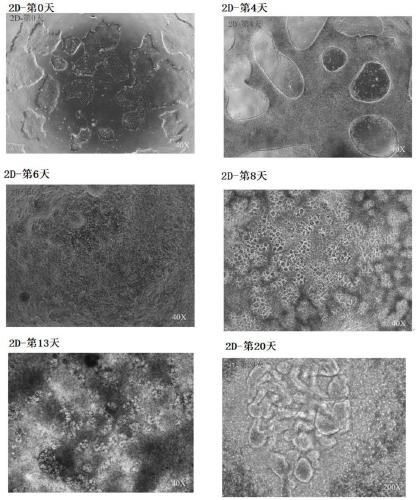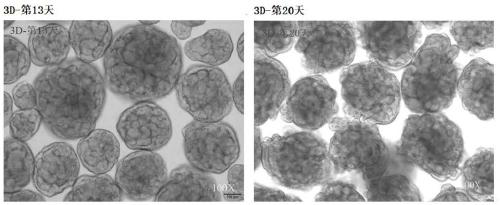Kidney epithelial cell and preparation method and application thereof
An epithelial cell and renal epithelium technology, applied in the field of stem cell biology, can solve the problems of low differentiation efficiency, inability to obtain renal epithelial cells, complex sources of medium components, and high differentiation cost, and achieve the effects of clear components, simple components and simple operation.
- Summary
- Abstract
- Description
- Claims
- Application Information
AI Technical Summary
Problems solved by technology
Method used
Image
Examples
Embodiment 1
[0156] This embodiment discloses a method for preparing renal epithelial cells, comprising the following steps:
[0157] S1: Pluripotent stem cells differentiate into posterior primitive streak cells;
[0158] S2: Posterior primitive streak cells differentiate to posterior intermediate mesoderm;
[0159] S3: Posterior intermediate mesoderm differentiates into renal progenitor cells;
[0160] S4: Renal progenitor cells differentiated into renal tubular aggregate precursors;
[0161] S5: Renal tubular aggregate precursors differentiate into renal vesicles;
[0162] S6: Renal vesicles differentiate into renal epithelial cells.
[0163] Specifically, the flow chart is as figure 1 As shown, the steps are as follows:
[0164] (1) Culture of pluripotent stem cells (D-3-D0)
[0165] The pluripotent stem cells used in the experiment have undergone strict pluripotency verification (expressing various pluripotency markers, and can form teratomas including inner, middle and outer ge...
Embodiment 2
[0209] This example discloses a method for preparing renal epithelial cells. The only difference from Example 1 is that step (5) "differentiation of metanephric mesenchymal cells to renal tubular aggregate precursors (Day8-10)" uses a 3D method nourish. Include the following steps:
[0210] The obtained renal progenitor cells were subjected to an embryoid body (EB) formation experiment, and the specific operation was: add 0.2-0.8 mL / cm2 to the differentiated renal progenitor cells 2 After incubating at 37°C for 3-6 minutes, pipette gently with a gun, transfer the cell suspension to a 1.5mL centrifuge tube, centrifuge briefly for 5-10s, and discard the supernatant. Add 0.2-0.8mL / cm 2 Resuspend the cells in complete differentiation medium D containing a certain concentration of Rock inhibitor and transfer to a low-adsorption culture flask, place on a three-dimensional shaker, 37°C, 5% CO 2 Concentration, cultivated in an incubator with saturated humidity. Cell density can be...
Embodiment 3
[0215] This example discloses a method for preparing renal epithelial cells. The only difference from Example 1 is that the sources of pluripotent stem cells are different, namely EGFP-iPSC, iPSC from polycystic kidney disease patients and iPSC from healthy people. The typical renal epithelial cell structure that can be obtained by the three cell lines (see image 3 ), indicating that the differentiation method disclosed in the present invention has universal applicability to various hPSCs.
PUM
 Login to View More
Login to View More Abstract
Description
Claims
Application Information
 Login to View More
Login to View More - R&D
- Intellectual Property
- Life Sciences
- Materials
- Tech Scout
- Unparalleled Data Quality
- Higher Quality Content
- 60% Fewer Hallucinations
Browse by: Latest US Patents, China's latest patents, Technical Efficacy Thesaurus, Application Domain, Technology Topic, Popular Technical Reports.
© 2025 PatSnap. All rights reserved.Legal|Privacy policy|Modern Slavery Act Transparency Statement|Sitemap|About US| Contact US: help@patsnap.com



